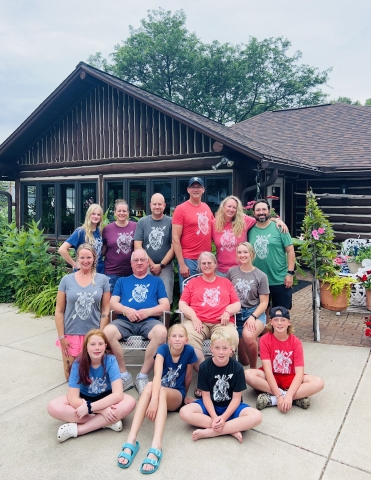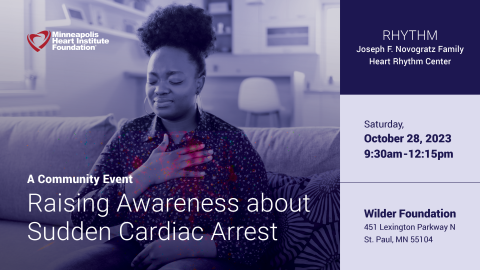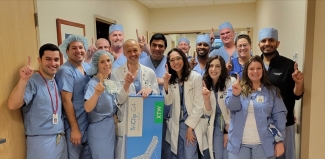Image

Alicia Bravo experienced sudden cardiac arrest (SCA) six years ago at age 37 – “in the best shape of my life” – as she swam in a lake, training for a triathlon.
Thanks to her father and other bystanders, who performed manual CPR until first responders arrived, she survived. She’s grateful to be alive. Since that time, Alicia has been working with her physician, Dr. Jay Sengupta, at the Allina Health Minneapolis Heart Institute to care for her heart and better understand what caused her cardiac event.
But gratitude isn’t the only emotion Alicia has experienced in the years since her cardiac event. “My SCA redefined who I was,” she says, and the transformation brought frustration and grief as well as gratitude.
Yet for years, she says, she felt like “I had to be thankful I was alive. I couldn’t be sad that I was no longer who I used to be.”
Alicia was, and remains, an ER nurse who has worked more than two decades at Hennepin County Medical Center (HCMC). Fitness was important to her. She was a runner and new to the sport of triathlon. She even ran Grandma’s Marathon two years after her SCA.
“Training for that was so much fun. I had never even done a half-marathon prior to signing up for Grandma’s. I started training in January or February.” Wherever she was during the first half of 2019, she ran. Her husband surprised her with a trip to New York City, planning the trip around a 16-mile training run in Central Park.
In June, says Alicia, “I finished Grandma’s. It was really special.”
Months later the pandemic arrived, changing everything.
On the front lines
At the height of covid, “the ER at HCMC was scary, overwhelming, and exhausting. It’s hard to even describe. At first we didn't know anything about [covid]. Then we learned that masks and vaccines were helpful. It was tough because so many people had different opinions and ideas about covid. I saw the reality of it firsthand.
“That’s when things got hard. My lifestyle changed a lot. My kids were home from school and I could no longer set my own schedule. I started to develop some depression and anxiety.”
It was difficult, she said, “to be sad even though I should be happy to be alive. I was so mad that I couldn’t swim and compete. I didn’t get to say that out loud for a long time.”
Then, “some things changed.” The pandemic abated. “Now my life is in better balance, and my goals have shifted a little bit.”
As part of Alicia’s ongoing care, she follows regular visits with her cardiologist Dr. Sengupta, who also is the director of the Joseph F. Novogratz Family Heart Rhythm Center at the Minneapolis Heart Institute Foundation. This center focuses on research that will bring new insights to the diagnosis and treatment of patients who are impacted by arrhythmias (irregular and life-threatening heart rhythms). For Alicia, it means she is part of a system that can help search for answers related to why she had her original cardiac event and if there is anything to learn from a genetic or hereditary link. So far, they do not think there is any hereditary link in Alicia’s case, but ongoing research like that will continue to further the understanding of how to best manage her case.
Alicia has transferred the passion she once poured into her fitness and triathlon training into making sure as many as people as possible understand the importance of bystander hands-only CPR. “Part of my own healing was making sure people won’t have to go through what I went through. I want everyone to be able to help. My mission in life is to teach hands-only CPR.”
Be brave
The biggest obstacle to saving lives with hands-only CPR is a bystander’s personal discomfort with touching a person they don’t know. “It’s ok to be uncomfortable; you can still help.” According to the American Heart Association, bystander CPR can double or triple a person's chance of survival, especially if administered immediately.
Image

Alicia trains her own colleagues in the ER for recertification in BLS (basic life support), but her bigger mission is to help non-medical people understand they too can help someone in cardiac arrest. She points out that bystanders are “the first step in the chain of survival. You don’t have to be a medical professional to help when you see someone in trouble.”
Alicia knows better than most people that “SCA can happen to anyone anywhere at any time. If you can learn these skills and be brave enough to step into help, you could save someone’s life. My dad’s hands were my heartbeat when I didn’t have one.”
In her personal time, Alicia supports and conducts training in hands-only CPR for groups: hockey teams, churches, neighborhood groups and others, including at MHIF’s upcoming event in October on raising awareness about sudden cardiac arrest. She helps people understand their natural reticence – and overcome it – to save lives.



